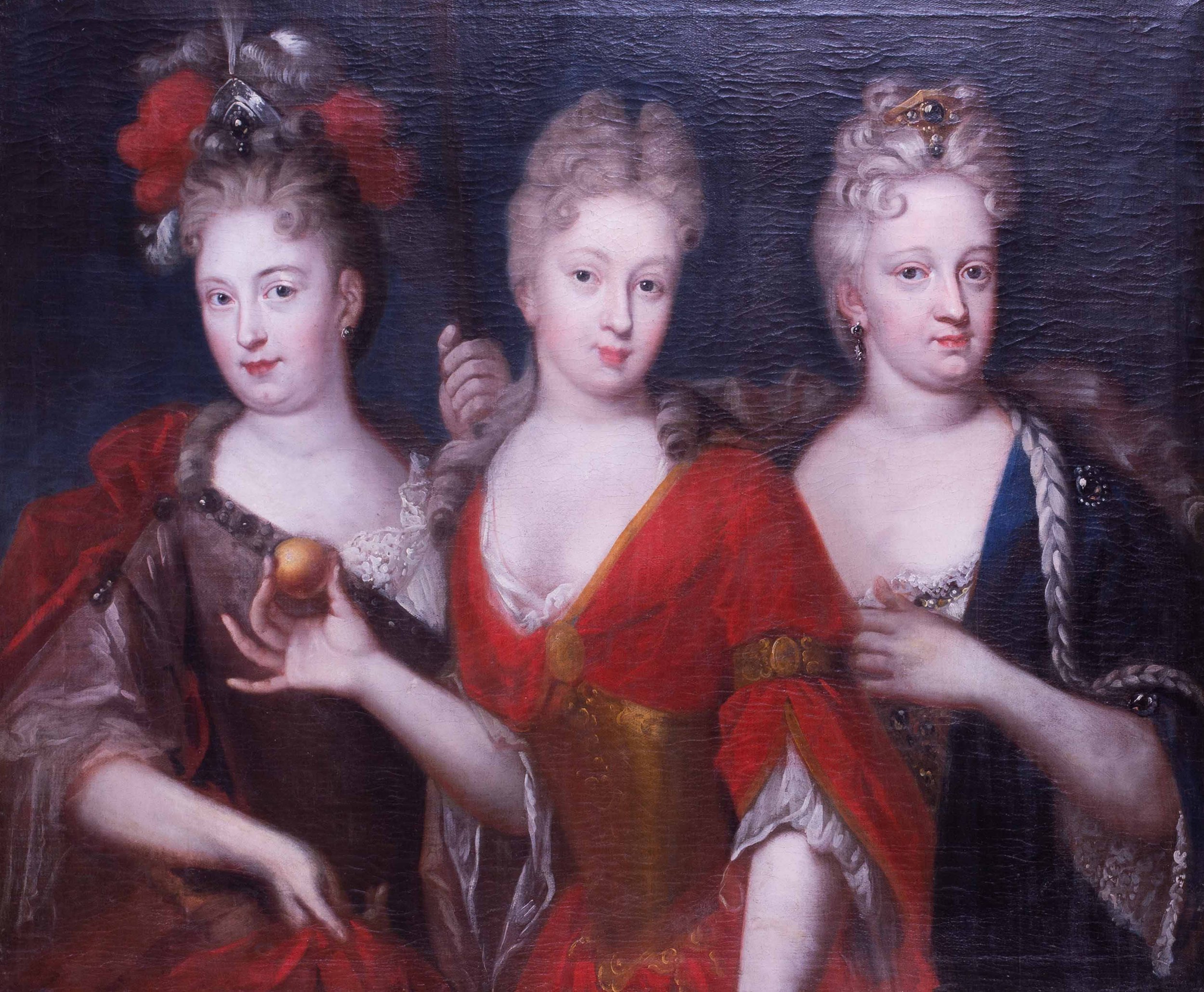Circle of Godfrey Kneller, 'Amelie Sophia von Wendt as Aphrodite'
Circle of Godfrey Kneller (German, 1646 – 1723)
Amelie Sophia von Wendt (George II’s Courtesan) as Aphrodite in the judgement of Paris.
oil on canvas
34.1/4 x 41 in. (87 x 104 cm.)
Provenance:
Historically at Bruggen Castle with the Countess of Steinberg. The sitter has been identified by the Historisches Museum Hanover.
Note: This captivating composition depicts the three von Wendt sisters, probably painted 1730 -1740. Amelie Sophia’s father Franz von Wendt was the governor of the fortress of Hamelin. Amelie Sophia married Count Gottlieb Adam von Wallmoden-Gimborn. George II was first attracted to the Countess Wallmoden in 1735 during a visit to Hanover. It is suspected she bore a son called Johanne Ludwig Graf von Wallmoden-Gimborn by him. He visited her on so many occasions that Samuel Johnson satirised the situation in his poem ‘London’. On the death of his wife Caroline of Ansbach in 1737 he requested her to join him in England furthering Johnsons disapproval writing ‘his tortured sons shall die before his face while he dies melting in a lude embrace’.
In 1739 she divorced her husband, and in 1740 was naturalised and bestowed the title of Countess of Yarmouth, the last royal mistress to be so honoured.
Circle of Godfrey Kneller (German, 1646 – 1723)
Amelie Sophia von Wendt (George II’s Courtesan) as Aphrodite in the judgement of Paris.
oil on canvas
34.1/4 x 41 in. (87 x 104 cm.)
Provenance:
Historically at Bruggen Castle with the Countess of Steinberg. The sitter has been identified by the Historisches Museum Hanover.
Note: This captivating composition depicts the three von Wendt sisters, probably painted 1730 -1740. Amelie Sophia’s father Franz von Wendt was the governor of the fortress of Hamelin. Amelie Sophia married Count Gottlieb Adam von Wallmoden-Gimborn. George II was first attracted to the Countess Wallmoden in 1735 during a visit to Hanover. It is suspected she bore a son called Johanne Ludwig Graf von Wallmoden-Gimborn by him. He visited her on so many occasions that Samuel Johnson satirised the situation in his poem ‘London’. On the death of his wife Caroline of Ansbach in 1737 he requested her to join him in England furthering Johnsons disapproval writing ‘his tortured sons shall die before his face while he dies melting in a lude embrace’.
In 1739 she divorced her husband, and in 1740 was naturalised and bestowed the title of Countess of Yarmouth, the last royal mistress to be so honoured.
Circle of Godfrey Kneller (German, 1646 – 1723)
Amelie Sophia von Wendt (George II’s Courtesan) as Aphrodite in the judgement of Paris.
oil on canvas
34.1/4 x 41 in. (87 x 104 cm.)
Provenance:
Historically at Bruggen Castle with the Countess of Steinberg. The sitter has been identified by the Historisches Museum Hanover.
Note: This captivating composition depicts the three von Wendt sisters, probably painted 1730 -1740. Amelie Sophia’s father Franz von Wendt was the governor of the fortress of Hamelin. Amelie Sophia married Count Gottlieb Adam von Wallmoden-Gimborn. George II was first attracted to the Countess Wallmoden in 1735 during a visit to Hanover. It is suspected she bore a son called Johanne Ludwig Graf von Wallmoden-Gimborn by him. He visited her on so many occasions that Samuel Johnson satirised the situation in his poem ‘London’. On the death of his wife Caroline of Ansbach in 1737 he requested her to join him in England furthering Johnsons disapproval writing ‘his tortured sons shall die before his face while he dies melting in a lude embrace’.
In 1739 she divorced her husband, and in 1740 was naturalised and bestowed the title of Countess of Yarmouth, the last royal mistress to be so honoured.






